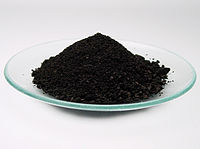
Photo from wikipedia
Feo, a ferrous iron transport system composed of three proteins (FeoA, -B, and -C), is the most prevalent bacterial iron transporter. It plays an important role in iron acquisition in… Click to show full abstract
Feo, a ferrous iron transport system composed of three proteins (FeoA, -B, and -C), is the most prevalent bacterial iron transporter. It plays an important role in iron acquisition in low-oxygen environments and some host-pathogen interactions. ABSTRACT Iron acquisition is essential for almost all living organisms. In certain environments, ferrous iron is the most prevalent form of this element. Feo is the most widespread system for ferrous iron uptake in bacteria and is critical for virulence in some species. The canonical architecture of Feo consists of a large transmembrane nucleoside triphosphatase (NTPase) protein, FeoB, and two accessory cytoplasmic proteins, FeoA and FeoC. The role of the latter components and the mechanism by which Feo orchestrates iron transport are unclear. In this study, we conducted a comparative analysis of Feo protein sequences to gain insight into the evolutionary history of this transporter. We identified instances of how horizontal gene transfer contributed to the evolution of Feo. Also, we found that FeoC, while absent in most lineages, is largely present in the Gammaproteobacteria group, although its sequence is poorly conserved. We propose that FeoC, which may couple FeoB NTPase activity with pore opening, was an ancestral element that has been dispensed with through mutations in FeoA and FeoB in some lineages. We provide experimental evidence supporting this hypothesis by isolating and characterizing FeoC-independent mutants of the Vibrio cholerae Feo system. Also, we confirmed that the closely related species Shewanella oneidensis does not require FeoC; thus, Vibrio FeoC sequences may resemble transitional forms on an evolutionary pathway toward FeoC-independent transporters. Finally, by combining data from our bioinformatic analyses with this experimental evidence, we propose an evolutionary model for the Feo system in bacteria. IMPORTANCE Feo, a ferrous iron transport system composed of three proteins (FeoA, -B, and -C), is the most prevalent bacterial iron transporter. It plays an important role in iron acquisition in low-oxygen environments and some host-pathogen interactions. The large transmembrane protein FeoB provides the channel for the transport of iron into the bacterial cell, but the functions of the two small, required accessory proteins FeoA and FeoC are not well understood. Analysis of the evolution of this transporter shows that FeoC is poorly conserved and has been lost from many bacterial lineages. Experimental evidence indicates that FeoC may have different functions in different species that retain this protein, and the loss of FeoC is promoted by mutations in FeoA or by the fusion of FeoA and FeoB.
Journal Title: mBio
Year Published: 2022
Link to full text (if available)
Share on Social Media: Sign Up to like & get
recommendations!